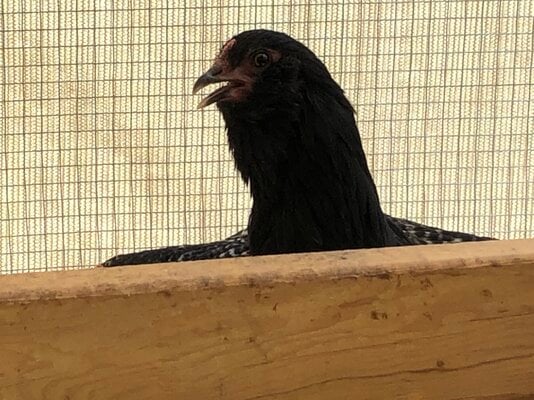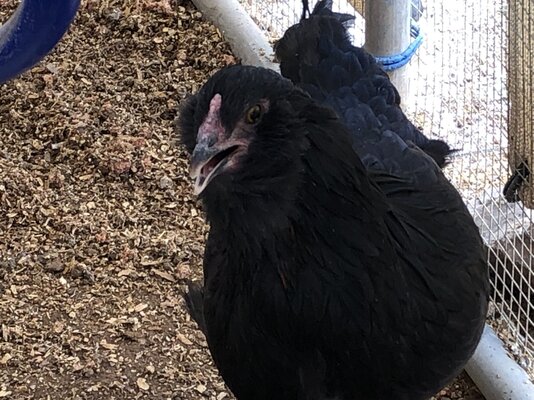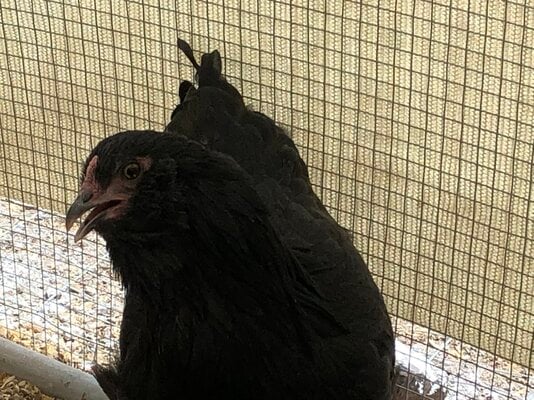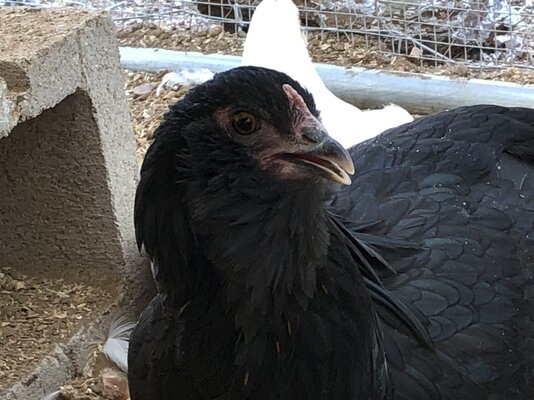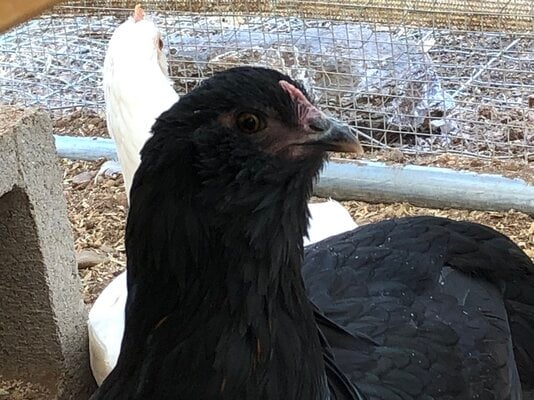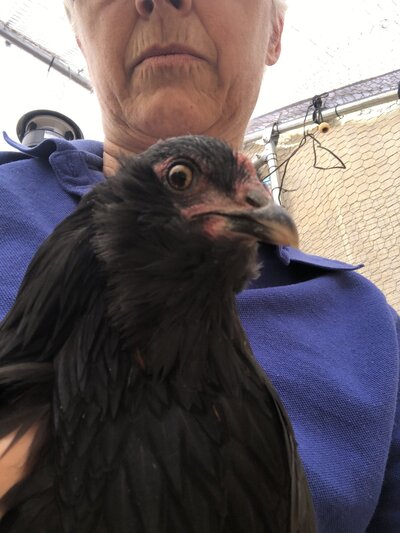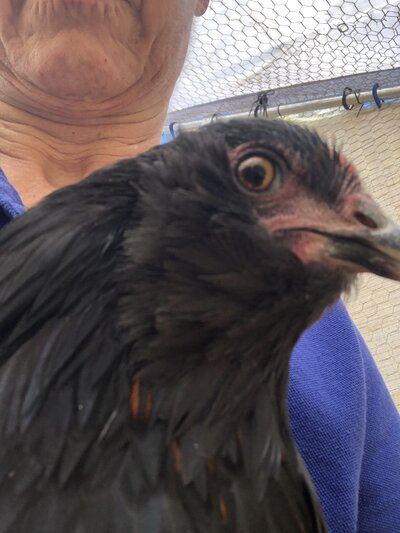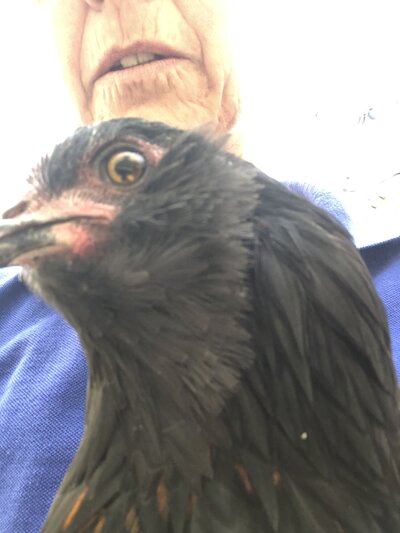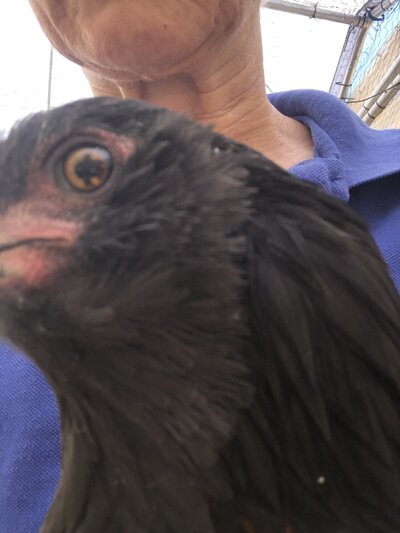I have a chicken hatched 3/8/22 from Ideal as part of a hatchery surprise and/or rainbow egg straight run. I noticed the colobomata (one in each eye) several weeks ago. Those of you who have knowledge and experience of them, how bad is this one? This bird and her flock were out of their pen for the very first time today, and she did appear to wig out trying to figure out how to get back inside. (or course, I've had various birds with perfect eyes act similarly). Is this likely to be painful to a free range chicken in a sunny climate, the way I feel when they dilate my pupils for an eye exam, or not to worry?
Navigation
Install the app
How to install the app on iOS
Follow along with the video below to see how to install our site as a web app on your home screen.
Note: This feature may not be available in some browsers.
More options
You are using an out of date browser. It may not display this or other websites correctly.
You should upgrade or use an alternative browser.
You should upgrade or use an alternative browser.
Colobomata in Ameraucana/easter egger
- Thread starter springvalley123
- Start date
C'mon guys I'm not that forgettable. 

With Marek's disease, specifically the ocular type, what I found in my chickens was that their pupils became very constricted. Medical terminology is pinpoint pupils. and the irises turn a nasty gray/green color that they will refer to as being 'gray eye'.
The birds develop what is the avian form of a herpes infection in their eyes called uveitis.
Iritis (i-RYE-tis) is swelling and irritation (inflammation) in the colored ring around your eye's pupil (iris). Another name for iritis is anterior uveitis. The uvea is the middle layer of the eye between the retina and the white part of the eye.Nov 13, 2019
I have a pic somewhere on BYC of my hen, Sassy's eye when she developed OMD but can't lay my fingers on it so this is off the internet.

The eye on the left is normal. The eye on the right is OMD.
It's a very painful condition. My birds did not like to be out in the bright light and would stay in shadows when they did venture out.
The oldest with OMD lived to be about 3 years old before she developed stroke like symptoms and had to be culled.
It's not a fun disease but the birds with OMD lived longer than the ones I had with neural or visceral Marek's.
The birds develop what is the avian form of a herpes infection in their eyes called uveitis.
Iritis (i-RYE-tis) is swelling and irritation (inflammation) in the colored ring around your eye's pupil (iris). Another name for iritis is anterior uveitis. The uvea is the middle layer of the eye between the retina and the white part of the eye.Nov 13, 2019
I have a pic somewhere on BYC of my hen, Sassy's eye when she developed OMD but can't lay my fingers on it so this is off the internet.
The eye on the left is normal. The eye on the right is OMD.
It's a very painful condition. My birds did not like to be out in the bright light and would stay in shadows when they did venture out.
The oldest with OMD lived to be about 3 years old before she developed stroke like symptoms and had to be culled.
It's not a fun disease but the birds with OMD lived longer than the ones I had with neural or visceral Marek's.
- Thread starter
- #19
I also meant to answer the question, as to what this girl's vision is like. This morning she reacted to another bird about 8 feet away who was chasing/got a bug. I don't know if this girl saw the bug, the bug move, or just the movement of the pullet but she went over and tried to get the bug!
You could try it on one or more of your other chickens, too. That would give you a good idea of what is "normal" for a chicken, and then you could better judge whether the one with the weird eyes is close to normal, or very different than normal.You can test to see how well her pupils are working by taking her into a dimly lit area and flashing a pin light in her eyes. Sweep it across her eye and look to see if her pupil is constricting. In dimmer light her pupil should be mostly open. When you shine a light into it it should constrict. Move the light and it should dilate again.
That is pretty strange. I have looked at a lot of colobomas in pictures of people and birds. My grandson has one in one of his eyes. But those look very different. Does the chicken seem to be able to see normally? They have been proven to be genetic before in studies. One of the BYC experts in Mareks has a husband who is an ophthalmologist, but I can’t remember which one. She might see this and have him take a look.
I'll tag her in for you. I think it's @microchickThat is pretty strange. I have looked at a lot of colobomas in pictures of people and birds. My grandson has one in one of his eyes. But those look very different. Does the chicken seem to be able to see normally? They have been proven to be genetic before in studies. One of the BYC experts in Mareks has a husband who is an ophthalmologist, but I can’t remember which one. She might see this and have him take a look.
I would come help but that would require pants.As for mareks, the eyes have looked like this for a very long time, and she's in with a flock whose eyes all look normal (otherwise normal also). I'll have to get her from the roost tonight and see if I can't take some closer pictures while holding her with one hand.
- Thread starter
- #15
Plus I'd have to count my chickens or make sure I don't end up short a black EE when you leave--I know you've been drueling over her!I would come help but that would require pants.
- Thread starter
- #18
New posts New threads Active threads
-
Latest threads
-
-
How do you deal with the heat for the ladies..?
- Started by PoppasGrill
- Replies: 3
-
-
Need help!! Sick chicken, breastbone protruding, she's not eating, advice pleass
- Started by Fur Babies Momma
- Replies: 1
-
-
-
Threads with more replies in the last 15 days
-
Open Contest May Madness, a Random Funny Posting Contest
- Started by casportpony
- Replies: 2K
-
-
Things I don't feed my chickens😊
- Started by ilovemybabychickies
- Replies: 153
-
-
Ended Official BYC Caption Contest 05-10-24 Pic by LavenderDaFlerf
- Started by BYC Project Manager
- Replies: 81
-

